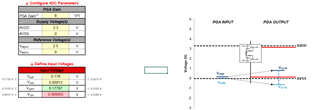Other Parts Discussed in Thread: ADS1248
Hello,
I have a thermopile sensor that gives min-max output between 0.134 mV and 178 mV. I used the ADS124S08 integration and gave the output of the thermopile directly to the ADC integration.
When we talked about this issue before, I found gain=16 V/V, but now I am not sure about this value. Because with this gain, the thermopile min-max value does not stay in the appropriate range and is not correct.
My question to you;
Can you give me a gain value that I can use in the software, taking into account the min-max range of the thermopile? With calculations, of course.




